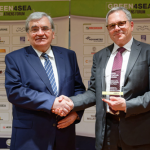The award is in recognition of WLPGA’s activities in promoting LPG as a marine fuel and for its report: “LPG Bunkering, Guide for LPG Marine Fuel Supply”. The report offers guidance for LPG marine fuel supply, concluding that sufficient potential infrastructure for distribution of LPG is available to serve potential marine market demand.
LPG is a key enabler for IMO 2050 and as fuel it addresses IMO sulphur regulation forever.
The report aims to improve understanding within the maritime industry, of issues related to bunkering ships with LPG. The report highlights that LPG is becoming the preferred fueling solution for LPG carriers. Currently, 26 VLGCs are being newly built or retrofitted to use LPG as a fuel. The first vessels will be operational in 2020. Other key areas addressed are design issues, current thinking on possible solutions to regulations requirements, safeguards and safe practices, as well as important areas of operational processes and training.
With the marine industry under pressure to take measures to reduce emissions to comply with IMO 2020 and align with the 2050 emissions strategy, LPG can make significant inroads into the marine fuel market. LPG propulsion, starting with the LPG carrier sector, needs to move beyond a niche fuel option, to gain acceptance in the wider shipping sector that it greatly deserves. Infrastructure for distribution and bunkering is largely available to serve potential marine market demand (vs other alternative fuels for which infrastructure still needs to be developed), and engine technology has been developed for a wide range of power outputs, requiring lower capex compared to other alternatives.
In the near future, economic incentives and the performance examples of the first vessels in operation, will attract more ship owners and operators to invest in LPG fueled fleets. LPG engine technology is now readily available and using dual fuel engines allows also operators during the trip, depending on price, to use LPG or compliant fuel, whichever is more economical. The report demonstrates that infrastructure for LPG is already in place for bunkering with LPG anywhere in the world. Supplies are also abundant, especially due to increased production coming from the US.





